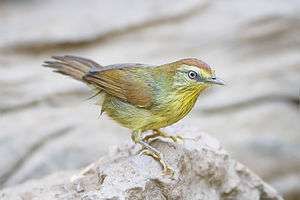Pin-striped tit-babbler
| Pin-striped tit-babbler | |
|---|---|
 | |
| Scientific classification | |
| Kingdom: | Animalia |
| Phylum: | Chordata |
| Class: | Aves |
| Order: | Passeriformes |
| Family: | Timaliidae |
| Genus: | Macronus |
| Species: | M. gularis |
| Binomial name | |
| Macronus gularis (Horsfield, 1822) | |
| | |
| Synonyms | |
|
Mixornis gularis | |
The pin-striped tit-babbler (Macronus gularis), also known as the yellow-breasted babbler, is a species of Old World babbler[1] found in South and Southeast Asia.
Taxonomy and systematics
The species has since been proposed to be included in the genus Mixornis following an analysis of both mitochondrial and nuclear genes that showed that the genus was not monophyletic, but has not yet been widely accepted. The pin-striped tit-babbler now belongs within a clade that includes the genera Dumetia, Timalia and Rhopocichla.[2]
The species has also been split following a study by Nigel Collar to distinguish the morphologically distinct Bornean and Javan populations, which have since been renamed the bold-striped tit-babbler (Macronus bornensis), from the rest of the pin-striped tit-babbler species complex.[3]
Description
The species has a distinctive yellowish supercilium and rufous crown. The throat is yellowish with brown streaks. Call is a loud repeated chonk-chonk-chonk-chonk-chonk somewhat reminiscent of a common tailorbird.
They forage in small flocks and creep and clamber in low vegetation. They breed in the pre-monsoon season from February to July and build a loose ball shaped nest made from grasses and leaves.
Distribution
.jpg)
The species is widely distributed and is found in Bangladesh, Bhutan, Brunei, Cambodia, China, India, Indonesia, Laos, Malaysia, Myanmar, Nepal, Philippines, Singapore, Thailand and Vietnam.[4]
In India, there are disjunct populations in southern India. This population was recorded by Salim Ali from Antharasanthe near the Kabini reservoir. There were no records of the species from this area after the initial collection. The southern population was rediscovered from the Masinagudi area in Mudumalai in 2004.[5]
Other populations are found in the northern Eastern Ghats.
References
- ↑
- Collar, N. J. & Robson, C. 2007. Family Timaliidae (Babblers) Pp. 70 - 291 in; del Hoyo, J., Elliott, A. & Christie, D.A. eds. Handbook of the Birds of the World, Vol. 12. Picathartes to Tits and Chickadees. Lynx Edicions, Barcelona.
- ↑ Moyle, Robert G.; Andersen, Michael J,; Oliveros, Carl J.; Steinheimer, Frank D. & Reddy, Sushma (2012): Phylogeny and Biogeography of the Core Babblers (Aves: Timaliidae) Syst. Biol. 61(4):631-651. doi:10.1093/sysbio/sys027
- ↑ Collar, N. J. (2006): A partial revision of the Asian babblers ( Timaliidae ). Forktail 22:85–112.
- ↑ BirdLife International (2004). "Macronous gularis". IUCN Red List of Threatened Species. Version 2006. International Union for Conservation of Nature. Retrieved 12 May 2006.
- ↑ Praveen J., Job K. Joseph & Nick Lethaby (2004) Sighting of Yellow-breasted Babbler Macronous gularis in South India. Newsletter for Ornithologists 1(3):43 PDF

